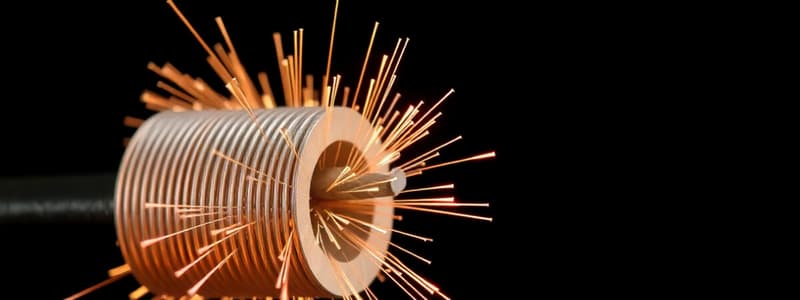Podcast
Questions and Answers
What happens to the magnetic force when the current in the wire increases?
What happens to the magnetic force when the current in the wire increases?
- It remains constant.
- It decreases proportionally.
- It becomes zero.
- It increases proportionally. (correct)
Which factor does NOT affect the magnetic force on a current-carrying wire?
Which factor does NOT affect the magnetic force on a current-carrying wire?
- Current flowing through the wire.
- Strength of the magnetic field.
- Length of the wire in the magnetic field.
- Temperature of the surrounding environment. (correct)
What is the role of the angle (θ) between the current and the magnetic field in determining the magnetic force?
What is the role of the angle (θ) between the current and the magnetic field in determining the magnetic force?
- It affects the magnitude of the force. (correct)
- It only affects larger wires.
- It has no impact on force.
- It determines the direction of the force.
What is the correct formula for calculating the magnetic force on a straight current-carrying wire?
What is the correct formula for calculating the magnetic force on a straight current-carrying wire?
In the right-hand rule for determining the direction of the magnetic force, where should the thumb be pointed?
In the right-hand rule for determining the direction of the magnetic force, where should the thumb be pointed?
What is the primary application of the magnetic force on a current-carrying wire?
What is the primary application of the magnetic force on a current-carrying wire?
Which of the following statements is true regarding the magnetic force on a wire?
Which of the following statements is true regarding the magnetic force on a wire?
What would happen to the magnetic force if the magnetic field strength is doubled?
What would happen to the magnetic force if the magnetic field strength is doubled?
For a curved wire carrying current, how does the magnetic force calculation change?
For a curved wire carrying current, how does the magnetic force calculation change?
What is the measured unit of magnetic field strength?
What is the measured unit of magnetic field strength?
Flashcards
Magnetic Force on a Wire
Magnetic Force on a Wire
The force a magnetic field exerts on a wire carrying an electric current.
Current (I)
Current (I)
The flow of electric charge; measured in amperes (A).
Wire Length (L)
Wire Length (L)
The portion of a wire within a magnetic field; measured in meters (m).
Magnetic Field Strength
Magnetic Field Strength
Signup and view all the flashcards
Angle (θ)
Angle (θ)
Signup and view all the flashcards
Force Equation (F=BIL sin θ)
Force Equation (F=BIL sin θ)
Signup and view all the flashcards
Right-Hand Rule
Right-Hand Rule
Signup and view all the flashcards
Electric Motors
Electric Motors
Signup and view all the flashcards
Solenoid
Solenoid
Signup and view all the flashcards
Straight Wire Formula
Straight Wire Formula
Signup and view all the flashcards
Study Notes
Defining the Magnetic Force on a Current-Carrying Wire
- The magnetic force on a current-carrying wire is the force exerted by a magnetic field on the moving charges within the wire.
- The force is proportional to the current, the length of the wire in the field, and the strength of the magnetic field.
- The direction of the force is perpendicular to both the current and the magnetic field, determined by the right-hand rule.
Factors Affecting Magnetic Force
- Current (I): A larger current results in a larger magnetic force. Measured in amperes (A).
- Length of the Wire (L): A longer segment of wire in the magnetic field experiences a greater force. Measured in meters (m).
- Magnetic Field Strength (B): A stronger magnetic field creates a greater force on the wire. Measured in teslas (T).
- Angle between Current and Field (θ): The angle between the direction of current flow and the direction of the magnetic field significantly affects the force. A greater angle results in a larger component of force.
Calculating the Force
- The magnitude of the magnetic force (F) on a straight current-carrying wire is given by the equation:
F = BIL sin θ
where:
- F is the magnetic force in Newtons (N)
- B is the magnetic field strength in teslas (T)
- I is the current in amperes (A)
- L is the length of the wire in meters (m)
- θ is the angle between the direction of the current and the magnetic field.
Direction of the Force
- The direction of the force is determined by the right-hand rule.
- Point your right thumb in the direction of the current.
- Point your fingers in the direction of the magnetic field.
- Your outstretched palm will then indicate the direction of the force.
Practical Applications
- Electric Motors: The principle of magnetic force on a current-carrying wire is fundamental to the operation of electric motors.
- Solenoids and Electromagnets: These devices rely on the force exerted on multiple current-carrying wires wound in coils to create concentrated magnetic fields.
- Measuring Magnetic Fields: The force on a known current-carrying wire in a magnetic field can be measured to determine the strength of the magnetic field.
Important Considerations
- The formula applies to a straight wire segment. For curved or complex wire shapes, the force calculation becomes more complex, often needing vector integration.
- The force is experienced by all moving charges within the wire, not just those at the surface.
- The force on a wire segment is perpendicular to the magnetic field and the current; therefore if the wire is perfectly parallel or anti-parallel to the field, the force will be zero.
Studying That Suits You
Use AI to generate personalized quizzes and flashcards to suit your learning preferences.
Description
This quiz explores the principles of the magnetic force experienced by a current-carrying wire within a magnetic field. It covers factors such as current, wire length, magnetic field strength, and the angle between current and field. Test your understanding of the right-hand rule and how these variables interact.



